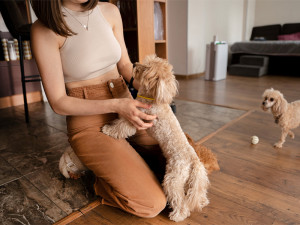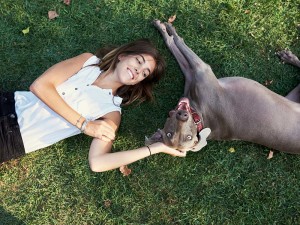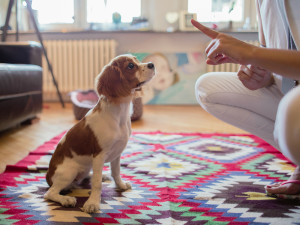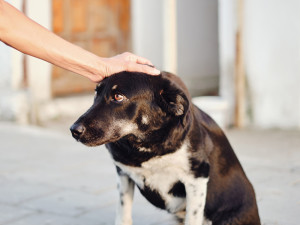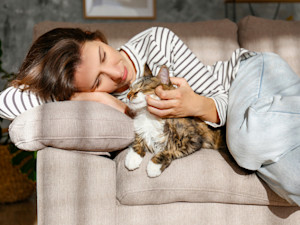Does My Dog Love Me? How to Interpret Canine Bonding Behavior
What to do when you don’t feel the close bond you want.

Share Article
In This Article:
Does My Dog Love Me? Do Dogs Feel Love? How Do Dogs Show Love? How to Make Your Dog Love You
I’m obsessed with love, always reading up on “how to tell if he really loves you,” and considering the love languages of everyone in my life. When I think of the ways love is expressed — gift giving, quality time, physical touch, words of affirmation, and acts of service — it always seems like dogs do it best. (Yes, even the words-of-affirmation thing because I love dogs so much I’ve spent my whole career learning to understand them well enough to imagine what they would say if they could. It’s fair to say I’m as obsessed with dogs as I am with love.)
I generally imagine a cartoon bubble over dogs’ heads expressing their true feelings. One of my favorite things is to tell people that it is my professional opinion that their dogs love them deeply. But how can I tell whether a dog loves their pet parents? By interpreting their behavior, their expressions or emotion, and the choices they make.
Main takeaways
Dogs are capable of true love, just as we have always suspected.
Dogs bond to their pet parents due in part to the same chemical — oxytocin — that bonds romantic partners as well as human babies and their parents.
Your dog’s behavior reveals the love they feel for you.
There are many ways to make your dog love you.
Does my dog love me?
I still think about this memory: I was sad enough to be crying, and my dog, Bugsy, sensed it. He generally wanted to be near me, but on this occasion, he even uncharacteristically declined a stuffed Kong on the floor to stay on the couch with me. My husband and I were living long distance, and we had just said good-bye for what would be an unusually long absence.

Bugsy offered great solace, licking my face, leaning into me, gazing into my eyes, and looking a little worried with a furrowed brow and an air of calmness. That’s the kind of love we need from our dogs, and though people often wonder if our dogs truly love us, I think deep down most of know that they do. It’s just that we’ve been taught not to assume dogs have the same emotions we do. That’s a shame, because all kinds of scientific evidence support the idea that they do. Knowing that makes us feel better, and denying it serves no purpose.
Do dogs feel love?
If you’re asking, “Do dogs feel love?” or “Do dogs feel love for their people?”, I recommend that you breathe a sigh of relief this instant because dogs love us just as we love them. Literally. We know this because of scientific studies of love, and it’s a beautiful thing to know people are investigating what really makes life worth living.
The same physiological and chemical reactions people experience in romantic love and in the love that forms between parents and babies are present in both species in the bond between dogs and people. Oxytocin, the so-called love hormone, makes all these types of love form and grow.
Do dogs love their pet parents?
“Does my dog love me?” is one of the top questions I hear from clients in the course of my daily work helping improve the relationship between people and their dogs. I wish everyone knew how real dogs’ love is for their pet parents. A scientific studyopens in new tab a few years back found that dogs and people who gaze into each other’s eyes develop feelings of love because of an increase in oxytocin levels, just as lovers or moms and babies who gaze into each other’s eyes do.
In fact, scientists believe that dogs got us to fall in love with them in the first place by hacking into this system of bonding. And I recommend being grateful they did, because the love we share with them is too pure and beautiful to imagine life without it. (Note: Gazing into the eyes of a dog you love can enhance your bond, but never stare into the eyes of a dog you don’t know or one prone to aggression, because staring can be taken as a threat.)
How do you know if your dog loves you?
It’s natural to ponder the question, “How do I know if my dog loves me?” That just shows you care, and frankly, it’s easy to judge someone who never takes a moment to google, “How to tell if my dog loves me?” And the answers are plentiful and right here for you to see, because dogs have a lot of ways to show you that they love you. Go ahead, make a list called “signs my dog loves me” and be excited about how long that list is.
Tail-wagging
Not all tail wags are signs of love and happiness, but when dogs wag their tails in an energetic but relaxed way or wag so hard that their whole body gets in on the fun, that’s the kind of behavior we see when they are happy to see someone and to be with them. Those they love the most are certainly going to inspire those enthusiastic tail wags, so if you interpret your dog’s wagging-from-the shoulders back and fully body wiggles as true love, I’m certainly in no position to disagree.
Relaxed body movements
In my experience, dogs who have strong bonds with their people tend to have relaxed body language. This shows a level of comfort with the people, and the closeness that comes when the relationship makes them feel at ease.
Don’t panic if your dog gets tense in certain situations such as when meeting strangers, seeing a coyote, going to the vet, or anything else out of the ordinary that they don’t enjoy. That has nothing to do with their love for you. I’m talking about when your dog is in their element, enjoying life with you. That’s when you see their comfort with you most, including eye contact in a relaxed manner, their mouth open in the universal sign of a happy dog, and a general expression of peacefulness rather than tension.
Rolling over to show their belly
Dogs roll over to show their belly for many reasons. Some dogs do this for the sake of appeasement, and in that case, it’s best to leave them alone. Other dogs are expressing their interest in playing, and some are doing this because they have learned the result will be a belly rub. In many of these situations, the dog is indicating they have a valued social relationship with you, and love is so often a key factor in relationships.
Leaning against you
One interpretation of a dog leaning against you is trust and affection. Dogs seem to seek comfort and reassurance from those they trust which is why it’s so often stated that leaning against you is a sign of a loving relationship. It’s also true that some dogs lean on people when they feel nervous, so it’s not always necessarily about love.
Lying on you (or near you)
I have often wondered, Why does my dog like to lie on me? This thought has occurred to me when I am sitting down, and there’s a dog lying on my foot. The question has also run through my mind when I am in bed with a dog covering me completely. I feel very loved (but also a little bit squished). It makes sense that dogs like to lay their bodies down on ours for the loving warmth and comfort that close physical contact offers. If your dog likes to rest on top of you, they are acting like loving dogs everywhere do.
Following you
When a dog loves you, they want to be close to you. If your dog is following you around the house when you are home and seeking interaction with you, they are clearly choosing to be near you — a behavior that individuals show when they feel love toward you.
Pawing you
Many dogs paw at people for attention, frequently to solicit petting. Dogs often seek physical affection from those they love, though plenty of dogs are happy for anyone to pet them. Of course, those may be dogs who really do seem to love everybody or perhaps are just a bit pushy. I feel comfortable assuming loving intentions in a dog who uses their paws to get attention, but I am one to see the best in every dog.
Licking
Why does my dog like to lick me? You would think based on the amount of time there’s a dog tongue on my skin that it is made of liver or cheese. There are many reasons dogs lick their pet parents, but one of them is definitely expressing affection. Dogs are often especially enthusiastic about licking the faces of those they love. Greetings of beloved people often involve lots of licking, and many dogs lick those who they want to be around before going to sleep, which may help soothe them into a restful night.
Sharing toys
Dogs often have especially strong feelings of love for the people who play with them. When a dog invites you to play by bringing you a special treasure as though they are sharing toys with you, that can be the sign of a strong bond and a relationship filled with love.
How to make your dog love you
Dogs tend to love those who spend quality time with them and those who make them feel safe and cared for. So, your quest about, “How to make a dog like me?”, should revolve around being fun, being present, and being kind so your dog will feel safe, secure, and loved.
Establishing a feeding schedule
Routine is important for a dog’s feeling of security and sense of wellbeing, so take care of your dog in a consistent, reliable way. One part of that is to stick to an established feeding schedule, and a routine in general. Dogs feel more secure when their world is predictable, and those feelings of security can help feelings of love develop.
Consistent play and exercise
In my experience, there is nothing more bonding than playing together. Across the animal world, individuals who play with each other have closer relationships than members of the same species who are less playful. Play also provides exercise, which is an important part of helping our dogs feel their best. When they feel their best, they show us their love and gratitude in return.
Consistent petting and grooming
Physical contact with our dogs affects our physiology and theirs in positive ways. Petting and grooming (as long as it is pleasurable for the dog!) influence their brain chemistry in the same way that romantic love and mother-baby connections do in humans.
Treats and reward
Being the source of good things will make just about any dog have good feelings about you. Offering treats and rewards through training is an especially powerful way to create a bond and strong feelings of love.
During training, your dog will receive all kinds of positive attention, and both of you are working together toward common goals and sharing the joy of accomplishing them. Training is a fun activity to do together, and your dog gets to associate that fun, plus the success of being right and earning treats, with you
Bottom line
Most people feel such strong love for their dogs that it’s natural to wonder if our dogs love us back. Luckily, loving their pet parents comes just as naturally to the typical dog as to the typical person. That means that the relationship between people and dogs really is true love, just as we have always hoped (and believed).
References
Baun, Mara M., et al. “Physiological Effects of Human/Companion Animal Bonding.” Nursing Research, vol. 33, no. 3, 1984, p. 126, journals.lww.com/nursingresearchonline/abstract/1984/05000/Physiological_Effects_of_Human_Companion_Animal.2.aspxopens in new tab.
“For the Love of a Dog: Understanding Emotion in You and Your Best Friend: Patricia McConnell: 9780345477156: Amazon.com: Books.” Amazon.com, 2024, www.amazon.com/Love-Dog-Understanding-Emotion-Friend/dp/0345477154opens in new tab. Accessed 17 Dec. 2024.
“How to Improve Your Relationship with Your Dog.” Kinship.com, 2024, www.kinship.com/dog-lifestyle/improve-your-relationship-your-dogopens in new tab. Accessed 17 Dec. 2024.
Kubinyi, Enikő, et al. “Oxytocin and Opioid Receptor Gene Polymorphisms Associated with Greeting Behavior in Dogs.” Frontiers in Psychology, vol. 8, 7 Sept. 2017, https://doi.org/10.3389/fpsyg.2017.01520opens in new tab. Accessed 3 Apr. 2021.
McConnell, Patricia. For the Love of a Dog: Understanding Emotion in You and Your Best Friendopens in new tab. New York: Ballantine Books, 2007.
Morey, Darcy F. “Burying Key Evidence: The Social Bond between Dogs and People.” Journal of Archaeological Science, vol. 33, no. 2, Feb. 2006, pp. 158–175, https://doi.org/10.1016/j.jas.2005.07.009opens in new tab.
Nagasawa, M., et al. “Oxytocin-Gaze Positive Loop and the Coevolution of Human-Dog Bonds.” Science, vol. 348, no. 6232, 16 Apr. 2015, pp. 333–336, science.sciencemag.org/content/348/6232/333.fullopens in new tab, https://doi.org/10.1126/science.1261022opens in new tab.
Payne, Elyssa, et al. “Current Perspectives on Attachment and Bonding in the Dog–Human Dyad.” Psychology Research and Behavior Management, vol. 8, Feb. 2015, p. 71, www.ncbi.nlm.nih.gov/pmc/articles/PMC4348122/, https://doi.org/10.2147/prbm.s74972opens in new tab.
Prato-Previde, Emanuela, et al. “Is the Dog-Human Relationship an Attachment Bond? An Observational Study Using Ainsworth’s Strange Situation.” Behaviour, vol. 140, no. 2, 2003, pp. 225–254, www.jstor.org/stable/4536022opens in new tab.
Romero, T., et al. “Oxytocin Promotes Social Bonding in Dogs.” Proceedings of the National Academy of Sciences, vol. 111, no. 25, 9 June 2014, pp. 9085–9090, www.pnas.org/content/111/25/9085opens in new tab, https://doi.org/10.1073/pnas.1322868111opens in new tab.
Wynne, Clive D. L. Dog Is Love: Why and How Your Dog Sees Youopens in new tab. New York: Mariner Books, 2019.

Karen B. London, PhD, CAAB, CPDT-KA
Karen B. London is a certified applied animal behaviorist (CAAB) and certified professional dog trainer (CPDT) who specializes in working with dogs with serious behavioral issues, including aggression. She has written for a variety of magazines including The Bark, Clean Run, and the APDT Chronicle of the Dog, and has published in scientific journals including Behavioral Ecology and Sociobiology, Ethology, Ecology, and Evolution, the Journal of Insect Behavior, and Insectes Sociaux. She is the author of seven books about dog training and canine behavior, including the forthcoming My Dog's Mystery Adventure: And Other Stories From a Canine Behaviorist and Dog Trainer.
Related articles
![Woman laying on the grass smiling at her dog]()
10 Ways You Can Make Your Dog’s Life Better
Number 6 will probably surprise you.
![Man hugging his fluffy white dog happily]()
Chemistry Between People and Dogs Is Real (It’s Science)
How the “love hormone” oxytocin connects us with our pups.
![Adorable puppy focused on learning commands at home in living room]()
Dog Training 101: What to Teach Your New Dog
In between cuddle sessions, work on these eight basic cues with your pup.
![Dog that looks unhappy being patted on the head by someone's hand while sitting on pavement outside]()
Uh, Why Doesn’t My Dog Like Getting Pet?
“No touch-y!”
![Woman petting her brown and white cat on the couch.]()
Does Your Attachment Style Affect How You Are as a Pet Parent?
You know you’ve wondered this...
Why Does My Dog Sit on Me?
“If I fits, I sits.”


